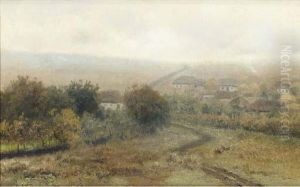Nicholas Alexandrovich Sergeev Paintings
Nicholas Alexandrovich Sergeev was a pivotal figure in the world of ballet, renowned for his contributions as a dancer, ballet master, and keeper of the traditional choreographies of the Imperial Russian Ballet and later, the Ballets Russes. Born in Russia in 1876, Sergeev's career spanned a transformative period in the history of ballet, bridging the opulence of the Russian Imperial theaters and the innovative explosion of the Ballets Russes in the West.
Sergeev's early career was rooted in the Imperial Ballet School in Saint Petersburg, where he trained before joining the Imperial Ballet. His talent and dedication soon elevated him within the ranks, and he became a respected member of the company. However, it was his work offstage that cemented his legacy within the ballet world. Sergeev took on the role of répétiteur and later became the head of the notational archives of the Imperial Theatres. In this capacity, he was responsible for documenting ballets using the Stepanov notation system, a method of recording dance movements that was used by the Imperial Ballet to preserve its repertoire.
The Russian Revolution of 1917 marked a turning point in Sergeev's career. With the fall of the Imperial regime, he, like many of his contemporaries, left Russia. He took with him a significant portion of the Imperial Ballet's notated scores, which would later become known as the Sergeyev Collection. This collection included the original choreographies for many of the classics by Marius Petipa, such as 'The Sleeping Beauty', 'Swan Lake', and 'The Nutcracker', among others.
Sergeev's arrival in the West coincided with the rise of the Ballets Russes, led by impresario Sergei Diaghilev. Although Sergeev did not work directly with Diaghilev's company, his possession of the Sergeyev Collection made him an invaluable asset to other ballet companies that sought to perform the classic Russian repertoires. Throughout the 1920s and 1930s, Sergeev worked with various companies in Europe and America, staging these classics and thus ensuring their survival and continued relevance in the global ballet repertoire.
During his later years, Sergeev settled in England, where he worked closely with the Sadler's Wells Ballet (now the Royal Ballet). Under his guidance, the company adopted many of the classic Russian ballets into their repertoire, enriching it with the authenticity and tradition that Sergeev carried with him from Russia. He continued to work as a ballet master and teacher until his death in 1951.
Nicholas Alexandrovich Sergeev's legacy is profound. Through his efforts, the rich tradition of Russian ballet was preserved and disseminated across the world, ensuring that the foundational works of Petipa and the Imperial Ballet continued to inspire and awe audiences for generations to come. His dedication to the art of ballet has made him a revered figure among dancers, choreographers, and historians alike.

